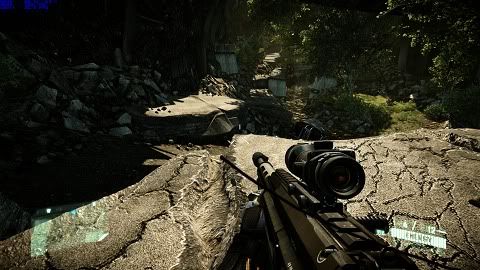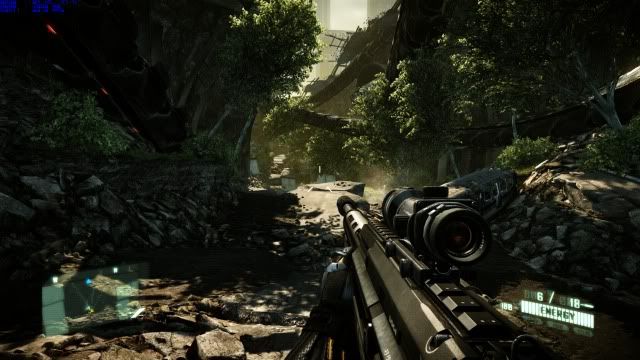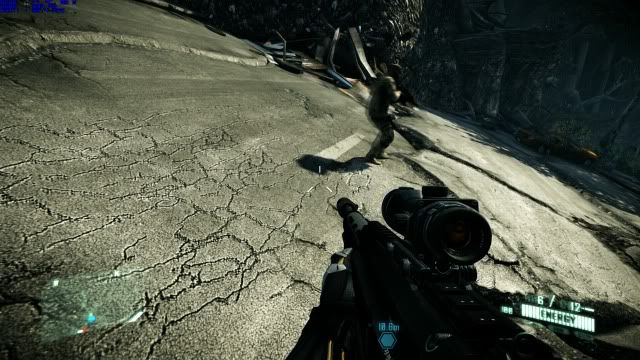You are using an out of date browser. It may not display this or other websites correctly.
You should upgrade or use an alternative browser.
You should upgrade or use an alternative browser.
VRAM Useage tests
- Thread starter Rastalovich
- Start date
Big WigglyStyle
New member
Don't have any screenies but using EVGA precision in BF3 I've recorded using 1350-1400 mb throughout games. My settings are the ultra preset but AA knocked down to 2x. 1920x1080 monitor
specs
i5 2500k (stock) limited by my intel stock cooler currently

ASRock Extreme4 Gen3 p67
8GB corsair vengeance ram
EVGA gtx 570 HD 1.2gb vram
I should also add that though going over the amount of vram I have available I get no stuttering or any sort of anomaly during gameplay all is smooth and perfectly fine. I tested it on low settings with the same 2x AA and gameplay felt the same despite a 15fps jump not sure about vram on low preset, didn't check.
specs
i5 2500k (stock) limited by my intel stock cooler currently
ASRock Extreme4 Gen3 p67
8GB corsair vengeance ram
EVGA gtx 570 HD 1.2gb vram
I should also add that though going over the amount of vram I have available I get no stuttering or any sort of anomaly during gameplay all is smooth and perfectly fine. I tested it on low settings with the same 2x AA and gameplay felt the same despite a 15fps jump not sure about vram on low preset, didn't check.
I Hunta x
New member
Ill grab some tests in the next few days for tf2, bf3, gotham city imposters and starcraft 2 for sure as ill probably be playing them and when im a bit bored/got time to kill ill try get Civ v, skyrim, Dawn of war 2, batman arkham asylum, blur, crysis warhead, farcry 2, gta 4, hydrophobia prophicy, Metro 2033, Portal 2, RAGE, R.U.S.E, stronghold 3, test drive unlimited 2 and mabey some others that can be fairly intensive at times over the next few weeks
Rastalovich
New member
Pentium 945D OC to 4.25GHz
560Ti Reference card
Crysis 2 DX11 high res pack everthing maxed out (except shaders on HIGH)
Dood, I can't read the screenie !
Loving the Pentium D action tho
Stevo
New member
Good stuff, I'm all for older and new gamesSome older games are better than new ones !!
Anyone posting/reading who's playing WoW would be great.
I'll do it when i get home tonight !, 1920 x 1080 ultra settings in say the most graphical encounter i know "Ultraxion 25man" hehe my GTX 580 only pulls rougly 30-45 fps on that boss so will be interesting to see how much VRAM it uses ! I'll also do a normal case scenario questing in the wilderness and doing laps of SW.
yassarikhan786
New member
Nice Screenies BKCXb, but I can't make out the OSD text.
Rastalovich
New member
hehe nope me neither, we'll get there.
Might help against the blackish background if the OSD was light green or similar, and the pics could be bigger.
Might help against the blackish background if the OSD was light green or similar, and the pics could be bigger.
Will look tomorrow, at mine as I need to install a few other games to be able to test properly with some demanding games, and some less demanding games.
But I will run the following games.
Crysis
Crysis Warhead
Crysis 2
Battlefield Bad Company 2
Battlefield 3
Medal Of Honor 2010
Call Of Duty 4
Call Of Duty 5
Call Of Duty MW2
Call Of Duty Black Op's
Call Of Duty MW3
Need For Speed Undercover
Need For Speed Hot Pursuit (new one)
Need For Speed The Run
May do some other's that I have but will need to sort my drives out as my ssd is just not big enough, but I have a long weekend off work so not really to much to do really.
But I will run the following games.
Crysis
Crysis Warhead
Crysis 2
Battlefield Bad Company 2
Battlefield 3
Medal Of Honor 2010
Call Of Duty 4
Call Of Duty 5
Call Of Duty MW2
Call Of Duty Black Op's
Call Of Duty MW3
Need For Speed Undercover
Need For Speed Hot Pursuit (new one)
Need For Speed The Run
May do some other's that I have but will need to sort my drives out as my ssd is just not big enough, but I have a long weekend off work so not really to much to do really.
yassarikhan786
New member
I'll have a look at some games as well tomorrow

Scoob
Active member
Interesting topic.
One thing I've found regards vRam usage is that pretty much every game I have ends up using over 1,200mb after some time. This is because textures get cached in the vRam as you play so, for the most part, vRam often appears quite heavily loaded.
For the record I have a pair of GTX 570's (1,280mb vRam) and run at 1920x1200. Being in SLI I basically max everything.
Things I've directly observed:
I can be playing Skyrim / Crysis 2 / Terran Conflict (niche title) and a variety of other games and I'll see my vRam usuage climb to ~1,250mb. I can then SAVE my game (or hit a checkpoint) quit and then reload the same scene and initially see a much lower vRam usage reported. I'm loading and doing a 360 to ensure all local textures etc. are loaded to render the scene. So, in the exact same place in the game where I was previously seeing ~1,250mb vRam used, I may now see ~700mb vRam used. This proves that data not directly needed to render the current scene/area was previously held, but purged after a save/reload. Usage will increase fairly rapidly as I continue to play of course.
I also think that developers must code to take advantage of vRam, permanently caching textures that are fairly common etc. Basically making the best use of the hardware available that they can.
The upshot is, from what I've observed, is that two PC's running the same game at the same settings but on GPU's with a different amount of vRam will often show the card with the greater vRam reporting a higher usage overall. Yet both systems can give near identical FPS. My SLI 570's with 1,280mb vs my friends SLI 480's with 1536mb vRam - both clocked at 800mhz core - give FPS within a margin of error in most instances, but his cards can report a slightly higher overall vRam usage after some play time.
Interesting stuff. Adding AA and other post-effects in games can of course impact vRam usage overall, this is to be expected. Yet even testing with AA and then without in a number of titles my vRam usuage pretty much always climbs to ~1,250mb. I have however NEVER seen the full 1,280mb reported as in use on my cards, the highest ever is around the 1,260 mark but maybe that is still maxed out due to how vRam is allocated or something.
Regardless, even when my vRam usage is at its highest, I've never been in an "out of vRam" situation where FPS tanks. The card/drivers/game seem to manage usage quite well. I guess it's a little like how Windows caches stuff you might need in system Ram so it loads faster. It makes sense that a developer would code to take advantage of vRam in this way. Also, at a driver / game level, for it to not purge data unless something current needs the space can also make things more efficient.
When I'm next at my gamer I will try to get some shots of Skyrim - I run a shed load of texture and mesh mods to make things prettier. Crysis 2 is just maxed in dx11 - I've not applied any of the texture mods to that, though I'm thinking about it.
Good work on starting this thread, I think it will paint an interesting picture of how modern GPU's utilise the vRam available to them. It also shows how GPU's which are considered to have "limited" vRam can still provide an excellent gaming experience.
One final observation, I'd be interesting if others concur here; Cards with less vRam are often low or mid-range cards these days. When increasing in-game settings these cards seem to run out of GPU power long before they run out of vRam. So, at high game settings, we start to see markedly lower FPS but not the total tanking of FPS we'd expect in an "out of vRam" situation.
I recall, back when I'd just got my Q6600 + 8800GT 512mb (new) and my friend and myself tried to run the original Crysis at 2560x1600 the card performed admirably and the game was perfectly playable - if a little way off the holy grail of 60fps
 - still, it was fine. Adding even 2x AA killed the card dead, barely 3 fps, a perfect example of "out of vRam". So, the GPU had enough power to play the game, but the extra vRam usage of just 2x AA was too much for it. Maybe a 1gb varient of the card would have taken far less of an FPS hit. An interesting comparison that would have been...
- still, it was fine. Adding even 2x AA killed the card dead, barely 3 fps, a perfect example of "out of vRam". So, the GPU had enough power to play the game, but the extra vRam usage of just 2x AA was too much for it. Maybe a 1gb varient of the card would have taken far less of an FPS hit. An interesting comparison that would have been...
Of course there are a lot of variables, resolution, game settings, the individuals preference of smooth FPS vs. graphical features etc. but this thread should help answer the question of how much vRam is "enough" - as subjective as that question may be due to the variable involved.
As is traditional for me, another long waffle

Cheers,
Scoob.
One thing I've found regards vRam usage is that pretty much every game I have ends up using over 1,200mb after some time. This is because textures get cached in the vRam as you play so, for the most part, vRam often appears quite heavily loaded.
For the record I have a pair of GTX 570's (1,280mb vRam) and run at 1920x1200. Being in SLI I basically max everything.
Things I've directly observed:
I can be playing Skyrim / Crysis 2 / Terran Conflict (niche title) and a variety of other games and I'll see my vRam usuage climb to ~1,250mb. I can then SAVE my game (or hit a checkpoint) quit and then reload the same scene and initially see a much lower vRam usage reported. I'm loading and doing a 360 to ensure all local textures etc. are loaded to render the scene. So, in the exact same place in the game where I was previously seeing ~1,250mb vRam used, I may now see ~700mb vRam used. This proves that data not directly needed to render the current scene/area was previously held, but purged after a save/reload. Usage will increase fairly rapidly as I continue to play of course.
I also think that developers must code to take advantage of vRam, permanently caching textures that are fairly common etc. Basically making the best use of the hardware available that they can.
The upshot is, from what I've observed, is that two PC's running the same game at the same settings but on GPU's with a different amount of vRam will often show the card with the greater vRam reporting a higher usage overall. Yet both systems can give near identical FPS. My SLI 570's with 1,280mb vs my friends SLI 480's with 1536mb vRam - both clocked at 800mhz core - give FPS within a margin of error in most instances, but his cards can report a slightly higher overall vRam usage after some play time.
Interesting stuff. Adding AA and other post-effects in games can of course impact vRam usage overall, this is to be expected. Yet even testing with AA and then without in a number of titles my vRam usuage pretty much always climbs to ~1,250mb. I have however NEVER seen the full 1,280mb reported as in use on my cards, the highest ever is around the 1,260 mark but maybe that is still maxed out due to how vRam is allocated or something.
Regardless, even when my vRam usage is at its highest, I've never been in an "out of vRam" situation where FPS tanks. The card/drivers/game seem to manage usage quite well. I guess it's a little like how Windows caches stuff you might need in system Ram so it loads faster. It makes sense that a developer would code to take advantage of vRam in this way. Also, at a driver / game level, for it to not purge data unless something current needs the space can also make things more efficient.
When I'm next at my gamer I will try to get some shots of Skyrim - I run a shed load of texture and mesh mods to make things prettier. Crysis 2 is just maxed in dx11 - I've not applied any of the texture mods to that, though I'm thinking about it.
Good work on starting this thread, I think it will paint an interesting picture of how modern GPU's utilise the vRam available to them. It also shows how GPU's which are considered to have "limited" vRam can still provide an excellent gaming experience.
One final observation, I'd be interesting if others concur here; Cards with less vRam are often low or mid-range cards these days. When increasing in-game settings these cards seem to run out of GPU power long before they run out of vRam. So, at high game settings, we start to see markedly lower FPS but not the total tanking of FPS we'd expect in an "out of vRam" situation.
I recall, back when I'd just got my Q6600 + 8800GT 512mb (new) and my friend and myself tried to run the original Crysis at 2560x1600 the card performed admirably and the game was perfectly playable - if a little way off the holy grail of 60fps
Of course there are a lot of variables, resolution, game settings, the individuals preference of smooth FPS vs. graphical features etc. but this thread should help answer the question of how much vRam is "enough" - as subjective as that question may be due to the variable involved.
As is traditional for me, another long waffle
Cheers,
Scoob.
Rastalovich
New member
I think the wider the field of examples, the more definitive we can be. Already there are observations of the games you can make as a generalization - as it stands, if you don't like games along the lines of BF3 & Metro a 1G card appears to be good for 1920x1080/1200. Need more info to be more more critical.
With that we can also look at the effects of larger resolutions at the same qualities. Then we can factor answers from users asking about cards, but have a 20"/22"/24"/2x screens/ etc etc etc, on those results with more of an educated reply than "you defo need 3G card for Total War !!!!.f//ss/pk!!".
Programmers of the engines definitely don't unallocate memory that's no longer required. Microsoft don't do it (although they're better than they were). But also in engines where perhaps you can go back a level/area or out of one instance to another, the engine uses more memory to allow you to do so, but if the game uses this engine and doesn't warrant retracing steps, there is no way to tell the engine not to keep the textures in cache ?? Purely guesswork cos I don't know. Keeping things cached for forward and backward movements in environments is a complicated thing.
Good stuff.
With that we can also look at the effects of larger resolutions at the same qualities. Then we can factor answers from users asking about cards, but have a 20"/22"/24"/2x screens/ etc etc etc, on those results with more of an educated reply than "you defo need 3G card for Total War !!!!.f//ss/pk!!".
Programmers of the engines definitely don't unallocate memory that's no longer required. Microsoft don't do it (although they're better than they were). But also in engines where perhaps you can go back a level/area or out of one instance to another, the engine uses more memory to allow you to do so, but if the game uses this engine and doesn't warrant retracing steps, there is no way to tell the engine not to keep the textures in cache ?? Purely guesswork cos I don't know. Keeping things cached for forward and backward movements in environments is a complicated thing.
Good stuff.
ThatBattlefieldGuy
New member
Here's some more results. This time on ULTRA,1080p on a fresh boot. ~1600MB




Big WigglyStyle
New member
Just finally decided to finish Mirrors Edge and decided I'd post my usage, on 1920x1080 everything set to highest with 16xQ antialiasing and PhysX on my max memory usage was 800mb usually it was below that but the highest it went was 800mb
specs
i5 2500k
gtx 570 1.28gb
8GB ram
specs
i5 2500k
gtx 570 1.28gb
8GB ram






